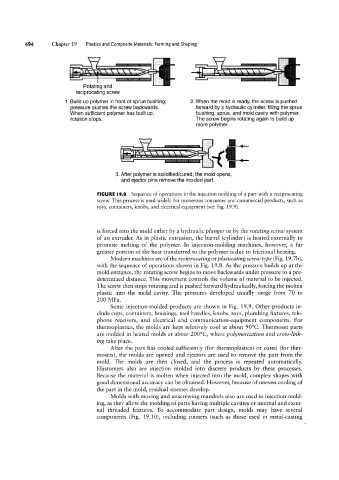Page 514 - 04. Subyek Engineering Materials - Manufacturing, Engineering and Technology SI 6th Edition - Serope Kalpakjian, Stephen Schmid (2009)
P. 514
Plastics and Composite Materials: Forming and Shaping
»» a a
¢'. iiss iffffssa ssa~s» » £4
Chapter 19 1 1
'i' ‘
};;V _,,;; ,i,, “_ i Em
»,ii,, ,¢§,,,,,
W_W_l,E
Rotating and if if if
reciprocating screw
1. Build up polymer in front of sprue bushing; 2. When the mold is ready, the screw is pushed
pressure pushes the screw backwards. forward by a hydraulic cylinder, filling the sprue
When sufficient polymer has built up, bushing, sprue, and mold cavity with polymer.
rotation stops. The screw begins rotating again to build up
more polymer.
f f
1
_'_‘_g,._ _ .“g. ._ ,_
VV;_V7VVW` M §‘ __f.t <1
za ___~_ ____ff.»....ff
3. After polymer is solidified/cured, the mold opens,
and ejector pins remove the molded part.
FIGURE l9.8 Sequence of operations in the injection molding of a part with a reciprocating
screw. This process is used widely for numerous consumer and commercial products, such as
toys, containers, knobs, and electrical equipment (see Fig. 19.9).
is forced into the mold either by a hydraulic plunger or by the rotating screw system
of an extruder. As in plastic extrusion, the barrel (cylinder) is heated externally to
promote melting of the polymer. In injection-molding machines, however, a far
greater portion of the heat transferred to the polymer is due to frictional heating.
Modern machines are of the reciprocating or plasticating screw type (Fig. 19.7b),
with the sequence of operations shown in Fig. 19.8. As the pressure builds up at the
mold entrance, the rotating screw begins to move backwards under pressure to a pre-
determined distance. This movement controls the volume of material to be injected.
The screw then stops rotating and is pushed forward hydraulically, forcing the molten
plastic into the mold cavity. The pressures developed usually range from 70 to
200 MPa.
Some injection-molded products are shown in Fig. 19.9. Other products in-
clude cups, containers, housings, tool handles, knobs, toys, plumbing fixtures, tele-
phone receivers, and electrical and communication-equipment components. For
thermoplastics, the molds are kept relatively cool at about 90°C. Thermoset parts
are molded in heated molds at about 200°C, where polymerization and cross-link-
ing take place.
After the part has cooled sufficiently (for thermoplastics) or cured (for ther-
mosets), the molds are opened and ejectors are used to remove the part from the
mold. The molds are then closed, and the process is repeated automatically.
Elastomers also are injection molded into discrete products by these processes.
Because the material is molten when injected into the mold, complex shapes with
good dimensional accuracy can be obtained. However, because of uneven cooling of
the part in the mold, residual stresses develop.
Molds with moving and unscrewing mandrels also are used in injection mold-
ing, as they allow the molding of parts having multiple cavities or internal and exter-
nal threaded features. To accommodate part design, molds may have several
components (Fig. 19.10), including runners (such as those used in metal-casting

